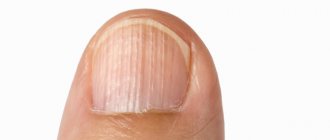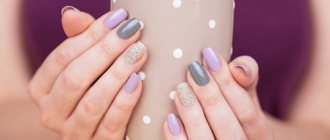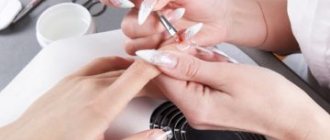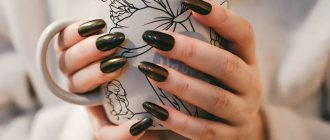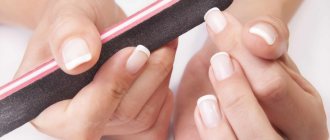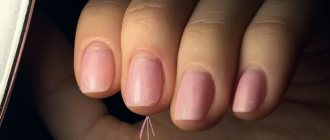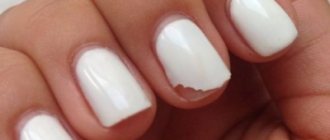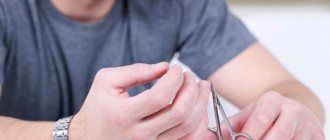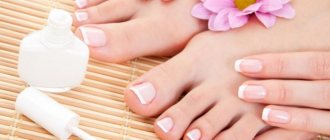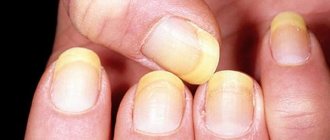Nails, like hair, are called appendages of the skin. In humans, they have lost their original protective function, but they have not lost the ability to reflect the state of the body. And a change in their appearance - fading, thickening or, conversely, thinning, as well as a change in color, indicates health problems. This may indicate both pathology in some organ and diseases of the nail plates themselves.
Today we’ll talk about why the fingernails of women and men turn yellow – when you should be afraid of it, and when you can limit yourself to a few local events to get them in order.
What healthy nails should look like
The nail plate should be uniformly pink, with only 2 white areas: a small crescent (lunula) at the base of the nail and the free edge. There should be no other white zones, as well as areas of a different color, on this keratinized appendage of the skin.
The nail plate has a shape close to ovoid (like an egg). If it acquires pronounced roundness and convexity, resembling watch glasses, this indicates conditions in which the tissues do not receive enough oxygen. This happens with diseases of the heart, lungs, bronchi and liver that occur chronically (for example, with heart defects, chronic bronchitis and others).
The cells that give rise to the nail are called the matrix. They are responsible for the shape, density, thickness and growth rate of the nail plate. The length and thickness of the matrix itself are determined genetically. The shorter it is, the thinner the nail plate, and this cannot be changed. But if the nail becomes thinner over time, this indicates that the growth zone is affected by a disease, which, by eliminating it, can improve the condition of the nail plate.
The matrix is located below the lunula and is covered with two layers of skin. Damage to it causes the nail to stop growing. Under the visible part of the nail there is a zone where matrix cells differentiate. It is rich in blood vessels, which is why it has a pink color.
If there are only a few layers of keratinized cells in the skin itself, then the nail plate is solid keratinized cells lying like tiles on a roof. This makes the nail permeable to moisture, which is absorbed and released here 100 times more intensely than in the skin, accounting for 12-15% of all exuded fluid. Varnishes and creams applied to nails can pass through the keratinized cells of the plate and land on the epithelium of the nail bed.
https://youtu.be/HACZmQsdMFE
What diseases does a change in the color of the toenail indicate?
A change in the color of the toenail indicates illness
Based on the external condition of the nail plate, an experienced doctor can conduct a preliminary diagnosis of the body and note the problem. What diseases does a change in the color of the toenail indicate? Often the onset of internal pathological changes can be determined based on the shade of the nail surface:
- Blue discoloration of the periungual fold, slightly yellowish color of the nail: diabetes mellitus
- White dots: liver disease
- Bluish tint: oxygen deficiency
- Pale color: the onset of anemia, probably malfunctions in the kidney system
- Thickening of the nail layer, slow growth: lung problems
But often nails can suffer from fungus. They exfoliate, crumble, peel off. Read more about the signs of fungal pathologies of the nail plates below. Read on.
Prevention
The fight against nail diseases is long-term, so preventive measures come first:
- Sanitary and hygienic rules during a manicure are the key to healthy nails. That is why instruments must be disinfected. If the skin of the nail fold is damaged during the procedure, it should be immediately treated with hydrogen peroxide.
- Carry out antifungal prophylaxis using special creams and nail baths.
- It is not recommended to use decorative varnishes on an ongoing basis. Nails need to breathe and recover, so you need to give them a rest from time to time.
- By giving up smoking, a person maintains his physical health, which has a positive effect on his nails.
Home Remedies
To whiten nails at home, use baths, masks and lotions based on:
- lemon and citric acid;
- toothpaste;
- hydrogen peroxide;
- vinegar;
- soda;
- essential oils.
Baking soda
You can use soda in two formats - as an independent product or as one of the components of the bath.
- for a bath - add 1 tsp to 1 liter of warm water. soda and lower the brushes for 10-15 minutes. The bath has a whitening effect and also strengthens nails. Monitor the temperature of the liquid - it should not be too cold, but not scalding - from 37° to 40°C.
- To whiten with soda, take a soft brush, for example, an unnecessary toothbrush, moisten it with water and pick up a small amount of soda. Gently brush the nail plate for no longer than 30 seconds per nail. After completing the procedure, wash off the remaining soda with warm water and lubricate your hands with cream.
Baking soda can be used once a week for as long as necessary until complete whitening occurs.
Lemon lotion
- Squeeze the juice from half a lemon;
- Soak a cotton pad with the juice and rub the juice into each nail;
- Leave for 15 minutes. then add warm water.
Do not use lemon juice if you have inflamed hangnails, wounds or abrasions - lemon juice irritates the skin and causes discomfort.
Toothpaste mask
- 1 tsp. Mix whitening toothpaste with 1 tsp. baking soda and stir;
- Apply the resulting mixture to your nails and leave for 15 minutes;
- Rinse off any residue by rubbing or using a soft brush.
Express mask with peroxide
- Mix hydrogen peroxide with water in a ratio of 1 to 2 - per 1 tsp. peroxide, 2 tsp. water;
- Add 2 tsp. toothpaste and wait until it stops foaming;
- Apply the mixture for 1-2 minutes, then rinse with warm water using massaging movements.
Vinegar bath
- In 1 l. add 1 tbsp warm water. l. vinegar 70%;
- Immerse your fingertips in the bath for 10-15 minutes;
- Rinse your hands well under warm running water, wipe dry and apply cream.
Hand baths: 30 recipes for different purposes
Salt bath
- Dissolve 1 tbsp in 1 liter of water. l. sea salt;
- Add 2-3 drops of tea tree oil to the bath and soak the brushes for 10 minutes;
- Rinse off the remaining salt, then moisturize the skin with cream.
Mask with oils
- 1 tbsp. l. Mix lemon with ylang-ylang and jojoba oil. 1-2 drops of each oil will be enough;
- Apply the mixture to your nails with a cotton pad and leave for 5-7 minutes;
- There is no need to rinse off the composition - just wipe your fingertips with a dry cloth.
All these recipes only mask the problem, but do not treat the cause if it lies in a disease or other pathology. The disappearance of yellowness does not always indicate recovery, so try to maintain your health and get checked regularly.
A guide to diseases and problems with nails: diagnosis, causes and remedies for 12 diseases
When the reason is the chemical composition of the nail coating
Often, nails turn yellow after varnish that contained a coloring pigment that was absorbed by the porous structure of the nail plate. But its color can also be affected by harmful substances contained in coatings (especially cheap ones). This:
- formaldehyde resin (formalin). Formalin itself is a carcinogen used to embalm dead animals;
- dibutyl phthalate (DBP), which is added to varnishes to protect them from chipping; may cause cancer;
- toluene: the more of this substance, the more “smooth” and “easy” it is applied. Leads to liver dysfunction;
- camphor oil: it gives greater plasticity to the varnish and improves its “adhesion” to the nail plate. In addition, camphor is a powerful allergen and toxic substance for the liver.
Varnishes containing these substances have a toxic effect on the liver, which is why these skin appendages turn yellow. Perhaps this is not from the first use, but after prolonged use with frequent “renewal” of the nail coating. You can eliminate this effect by carefully choosing varnishes (you need those that say “Big 5 free” or at least “Big 3 free”). In addition, even the most ordinary varnish must be applied not directly to the nail, but onto a varnish base. This substance will, like a sponge, absorb natural fluid that is removed from the body through the skin appendages: after all, if the effusion penetrates the coloring pigments of the coating, it will help them “absorb” into the nail plate.
A situation often arises when the gel on the nails turns yellow. The reasons for this may be the following:
- The presence of nitrocellulose in the varnish, and not its synthetic substitute - CBA. Being a product of mixing cotton or wood fibers with aggressive acid - sulfuric or nitric, it is necessary to obtain a bright glossy film on the nails. But when it gets on the nail plate, nitrocellulose will be very fragile and will move away from its surface as soon as it once again (this happens all the time) changes the shape of its curvature. To prevent this from happening, plasticizers - dibenzoates - are added to the varnish. During prolonged wear, which is typical for gel polishes (they were invented for this purpose), this composition leads to yellowing of the varnish. Therefore, before purchasing or applying shellac in a salon, ask about its composition: it should say “CBA” and not “Nitrocellulose”
- The components of tobacco smoke (nicotine and tar) can also turn the varnish, gel or skin appendages themselves yellow. In this case, you may notice that the nail on 1 or several fingers of the hand—the one holding the cigarette—has turned yellow. The nails of the second hand and toes did not change color.
- Exposure to sunscreens combined with solarium tanning. This “complex” can change the light color of acrylic or gel polish to yellowish, iodine yellow, and even brown.
- Components of household chemicals can change the color of the applied coating. Please note, maybe you clean the bathtub with Comet powder or wash the stove with another product without wearing gloves? Nail service professionals claim that a reaction between the components of even the most expensive coating and ingredients from household chemicals without gloves is inevitable.
- We can assume that the nails have turned yellow from the varnish, but in fact, after applying it, the woman is actively in contact with various chemical compounds not from household chemicals. Thus, the most common complaint is that the yellowness appeared after peeling carrots or preparing homemade preserves.
Acrylic can also turn yellow if:
- it itself is not of high quality - it contains few substances that suppress the effect of ultraviolet radiation on the color of the coating;
- the woman herself removes the top gel layer after a while, covering the nail with colorless varnish;
- cover acrylic immediately with a topcoat, without gel;
- use a topcoat without a sticky layer.
Whatever the reason, if the nails turn yellow after varnish, and not due to any diseases, this is characterized by the following signs:
- Varnish/gel polish of bright colors was used;
- the color changed only on those nails that were painted in this tone;
- you do not take any pills all the time;
- the yellowing did not appear after visiting the pool, wearing someone else's shoes or using someone else's towel;
- the state of health has not changed;
- the hands have a normal color, and if you move the lower eyelid in front of the mirror and look at the whites of the eyes, they do not turn yellow.
Prevention of toenail diseases: recommendations
Prevention of toenail diseases
As a rule, for the health of nails on the fingers and toes, only proper care is necessary. To keep your nails strong and beautiful, you can follow several general recommendations for disease prevention:
- During a pedicure, file your nails in one direction. This will avoid further delamination.
- Introduce the necessary vitamins and mineral supplements into your diet.
- Use a nourishing moisturizer for dry feet.
- When visiting the pool or sauna, use personal hygiene products, wash thoroughly, and wipe your feet dry. Following all these steps will help you avoid fungal infection.
- Get a pedicure only in trusted salons, where all instruments are disinfected.
- Choose the right shoes. This will avoid many problems associated with the development of leg diseases.
There are a lot of diseases of toenails and almost all of them are characterized by external changes in the plate, its shade and structure. If you are concerned about changes in the condition of your nails, you should consult a good dermatologist. The doctor will conduct an external examination and take the necessary tests. If the nails react to serious internal disorders, he will refer you to the necessary specialist. Good luck!
Cosmetic diseases
Fungus
Another possible cause of yellow nails is a fungus. It produces coloring pigments and destroys the nail plate, which leads to this result. So this version will be supported by uneven color, separation, changes in the thickness and structure of the nails.
Mycosis of nails
Onychodystrophy or mycosis of the nails is also a cause of yellowing. And in this case, it is important to know that this is a disease that under no circumstances should be neglected, otherwise it will take a long and difficult time to treat.
All of the listed causes of yellowing of nails are relatively harmless and can be corrected if desired. Then the natural color of the nails will be restored. But, unfortunately, a change in the color of the nail plate can be a signal of more serious troubles.
Anonychia - why the toenail does not grow: reasons
Anonychia - the toenail does not grow
Anonychia, or the absence of a nail plate on the toe, is quite rare and is most often a hereditary anomaly. The risk of acquired morbidity is less than 3% .
Possible causes of the disease are:
- Chronic pathologies
- Skin diseases, dermatoses
- Mechanical injury to the nail bed
A congenital defect, when the nail does not grow, unlike an acquired one, cannot be treated. The only way out is to disguise it.
External causes or temporary yellowing
When your nails turn yellow, the reason may be:
- Taking certain medications for a long time. This effect can occur due to the use of Ciprofloxacin, Norfloxacin, Gatifloxacin, Doxycycline, Tetracycline, Aminarsone, Sodium Arsenate, Duplex, Novarsenol.
- Smoking - in this case, the nails on one hand turn yellow, usually on the thumb, index and middle fingers. The fingers below these nails also turn yellow, acquiring a specific smell.
- If only your fingernails have turned yellow, remember what new household chemicals you started using. These can be cleaning pastes and powders, glass cleaning sprays.
- Nail polish remover containing acetone can cause yellow nails. In this case, the nail plates of the changed color will not be everywhere, but only where the woman often removes the polish.
- Drinking large amounts of tea or coffee. Both of these drinks contain a pigment that has a coloring effect on the skin, teeth and nails.
- Collecting or cleaning walnuts whose green shells and leaves contain iodine. In small quantities it stains nails and fingers yellow, in large quantities – brownish-black.
Dealing with yellowness in this case is simple - you need to eliminate the influence of the above chemical compounds (for example, stop smoking or use household chemicals with gloves). In order not to wait until the nail plates are completely renewed (this will take 96-115 days), you can use folk remedies or cosmetics, which we will describe at the end of the article.
Reasons for green nails
Yellowing of nails is a well-known and common problem that affects millions of people around the world. It happens much less often that nails acquire a greenish tint. There are only two reasons for this pathology - fungal or bacterial infection of the nail plate:
- Improper nail care, feet in constant dampness and uncomfortable shoes are ideal reasons for the development of mold. The disease has a high rate of spread, so treatment for the disease should be started as soon as possible.
- Pseudomonic onychia, a bacterium that can penetrate through microtraumas on the surface of the skin of the fingers and nails, becomes a common cause of greening of the nail plates.
The cause of green nails may be a fungal or bacterial infection.
Drug treatment
If the cause is nail fungus
To get rid of fungal nail infections, use special fungicidal varnishes and liquid products intended for treating the nail plate:
- Batrafen varnish, which contains ciclopirox, which fights fungus;
- varnish Loceryl (active ingredient – amorolfine);
- Demicten varnish (attention: it contains poisonous formic aldehyde, but it does not pose a danger for local, limited use);
- medicinal liquid Exoderil (active ingredient - naftifine).
Which product should you choose and which one is more effective in fighting fungus? It should be remembered that all appointments are made by the doctor. And the patient’s task is to use the drug, following the instructions, and adhere to the recommendations regarding secondary prevention. It is necessary to be patient (the treatment is long!) and not to skip treatment procedures. Only in this case will victory over the fungus be guaranteed.
If the cause is common diseases
If a person’s fingernails have turned yellow due to the presence of some internal disease, it is recommended to undergo an examination and consult with a therapist, dermatologist, infectious disease specialist, or endocrinologist. After receiving the test results, the doctor will prescribe a course of treatment.
Advice: do not mask the yellowness of the nail plates. Colored varnishes can only aggravate the problem. In this case, correctly prescribed therapy for the underlying disease will help.
What is onychomycosis: toenail fungus
Onychomycosis: toenail fungus
Problems with toenails and fingernails are caused by dermatomycetes, yeasts or molds. The disease goes through several stages of infection. Initially, external changes are minor - only small gray furrows are visually visible on the nail.
Without timely treatment, the disease enters the normotrophic stage. Its symptoms are already more pronounced:
- Dullness of nails
- The appearance of small yellow or white dots on the plate
- Delamination, fragility
Later, the situation may worsen. The symptoms of the disease include a purulent infection that has an unpleasant odor. Due to intoxication of the body, signs of an allergic reaction may appear on the skin - rash, irritation.
The main causes of onychomycosis are:
- Visiting public institutions - sauna, bathhouse, swimming pool
- Injury to the nail plate
- Long-term use of strong medications
This is a very serious disease that requires urgent treatment. If you have any signs of it, immediately contact a dermatologist or mycologist.
When yellow nails are a sign of illness
Yellow toenails or fingernails may indicate illness. These can be both pathologies of the whole body and diseases specifically of the nails.
Onychogryphosis
This is the name of a hereditary change in the nail shape when the nail becomes:
- dirty yellow color;
- hard;
- dull;
- acquired a curved shape;
- rose up and became thicker.
Either one or several nails can be damaged, becoming similar to the claws of a bird. Only the little toes may be affected.
Acquired onychodystrophy
This is the name of the condition when the blood supply to the nail plates is disrupted. It occurs as a result of a number of diseases:
- pneumonia;
- scarlet fever;
- measles;
- dysentery;
- typhus and typhoid fever;
- varicose veins;
- atherosclerotic lesions of blood vessels in the arms or legs;
- syphilis;
- various neuritis;
- multiple sclerosis;
- hypovitaminosis: mainly with hypovitaminosis A and pellagra - deficiency of vitamin PP and proteins (vitamin C deficiency is manifested by bruises under the nail plates and their detachment).
In the last five cases, onychia can act as the only symptom, so when making such a diagnosis, an examination is necessary to determine its causes.
Dystrophic onychias are described as “the toenails turned yellow” or “the fingernails turned yellow.”
This diagnosis is considered if:
- the nails have turned yellow and are moving away, and they are moving away from the free edge towards the lunula;
- became dull;
- acquired a yellowish-gray color;
- arcuate transverse stripes and pinpoint impressions appear on top;
- their fragility has increased;
- the plates are split longitudinally, starting from the free edge.
If similar symptoms are observed on one finger (for example, the big toenail turns yellow), this indicates trauma to the nail bed - for example, from uncomfortable shoes, from an impact, or from a manicure/pedicure.
Psoriasis
This skin disease does not always begin with a skin lesion - a shortening of the development cycle of skin cells and the layering of a large number of them can also begin with the nails.
Characteristics:
- clouding of the nail plate;
- the appearance of depressions and grooves on the nails, which makes it look like a thimble;
- without any redness in the area of the lateral ridges of the skin, the nail peels off - all or part of it;
- Until the nail plate falls off, dirt gets into the space between it and the skin, and epithelial particles accumulate. Because of this, it seems that the nail has acquired an off-white color;
- after a while, hemorrhages appear under the affected nails - spots of pink, reddish, burgundy or black;
- at the final stage of the disease, the nails are cloudy, rough, flat or even concave, and dirty yellow.
Fungal nail infection
If your toenail turns yellow, but you didn’t rub your toe, didn’t hit it, no one stepped on it, and you didn’t use new polish or acetone, it could be a fungal infection of the nail (onychomycosis). In most cases, the cause of the disease is the fungus Trichophyton, Epidermophyton, Microsporium. 20-40% of the pathology is due to aspergillus, fusarium and scopular mycosis. Candida, which causes thrush, can also cause yellowing of the nail plate on the big toe.
The fungus rarely affects only the nail, causing inflammation. It often spreads from infected toes and heels. The pathogen can be carried through the bloodstream from an area of inflammation (for example, from the lungs). People who suffer from diabetes, receive chemotherapy or radiation treatment, or take glucocorticoid hormones to maintain a decent quality of life with systemic diseases are more likely to “bring” mycosis from a public pool or shower.
Mycosis usually begins on the big toes or little fingers; The hands are less commonly affected. Symptoms vary depending on the type of pathogen and the state of your own immunity. There are 3 forms of damage to the nail plates:
- Hypertrophic. It is distinguished by the fact that the nail has become thick and yellowish. Its surface remains smooth for a long time, then peels off, loses its characteristic shine, and acquires jagged edges.
- Normotrophic. At the same time, yellowish and whitish zones appear in the thickness of the nail plate, but the nail itself does not thicken or peel off; its shape remains unchanged.
- Atrophic. The nail plate becomes thinner, peels off from the underlying skin, and may collapse.
What are toenail diseases?
Toe nail disease
The main external sign of a healthy nail is a smooth, slightly shiny plate of pale pink color. What are toenail diseases?
Unfortunately, negative changes in its type appear quite often and at any age, being not only a consequence of injuries, but the first symptom of serious problems in the body. Dermatologists conventionally divide all nail diseases into fungal and non-fungal.
Changes in the structure of the nail plate, non-fungal, are provoked by:
- Malfunctions of the endocrine system
- Neurological diseases
- Gene abnormalities and defects that are inherited
- Traumatic situations
- Hereditary predisposition
- Lack of vitamins and microelements in the diet
- Skin diseases, infections
- The use of tobacco products and their effect on the body
All of the listed symptoms, except for damage to the internal system of the body and congenital anomalies, are quickly eliminated as soon as a person begins to be more attentive to his health. A necessary consultation with a dermatologist, identification through diagnosis of the causes of nail lesions, and subsequent long-term treatment will require fungal diseases. They are characterized by the rapid proliferation of pathogenic microorganisms in conditions of high temperature and humidity.
Causes not related to disease
Smokers often notice yellow discoloration on their own nails. Smoking abuse leads to the accumulation of harmful tars and nicotine in the plates. In this case, it will not be possible to completely get rid of yellowness. All methods of eliminating the problem will give a short-term effect until the person gives up smoking.
Yellowness of the nail tissue is also provoked by drinking plenty of strong tea or coffee. Some people's nails turn yellow while taking antibiotics. Medicines have an aggressive effect on the body, spoil the intestinal microflora and undermine the immune system. All this impairs the absorption of nutrients and affects the condition of nails, skin and hair. They always react to negative changes inside and signal health problems.
The cause of yellow fingernails in women may be excessive use of solariums and tanning under the hot sun. Like skin, nails must be protected with special means while tanning. If women do not wear rubber gloves when regularly using household chemicals and dyes, this subsequently also leads to a change in the color of the nails.
If a girl carefully cares for her hands and regularly gets her nails done, she may also notice over time that the plates have turned yellow. A manicurist will tell you why nail polish turns yellow. Constant coating with varnish makes it difficult for the plates to breathe. With a lack of oxygen and nutrition, the condition and color of the marigolds worsen. When choosing a varnish, you need to study its composition - if the product contains nitrocellulose, your nails will turn yellow with constant use.
If fashionistas prefer bright and dark colors of varnishes, the reason for their yellow nails will be the abundance of color pigments. Substances are absorbed by the plates and cause yellowing.
Functional causes of yellowing
Yellow fingernail syndrome occurs not only among the fair sex, but also among men. If you ignore smoking and undergo an examination of the body, you can identify diseases of the lungs, liver, lymphatic and immune systems, and endocrine disorders.
With jaundice, chronic bronchitis and high levels of bilirubin, the nails acquire a yellowish tint.
What other diseases cause yellowing of fingernails:
- Onychogryphosis is a disease of the nail plates, which can be congenital or acquired. It manifests itself as yellowness, compaction and claw-shaped plates.
- Onychomycosis is a nail fungus. Infected plates thicken, flake, turn yellow and, in advanced situations, are rejected by the bed.
- Onychia is a nail dystrophy characterized by dullness and a yellow-gray tint of the plates on which transverse stripes are visible. Onychia develops with pneumonia, dysentery, rubella, scarlet fever, measles, nervous disorders, and syphilis.
- Hypovitaminosis, atherosclerosis, rheumatism, intoxication, varicose veins - pathologies make the nails gray-yellow, dotted with longitudinal grooves.
- Psoriasis is an autoimmune disease that affects not only the skin, but also the nails and bones. By affecting the nails, the pathology changes their condition completely. The plates have a dull yellow color and a thickened structure, the skin ridges around them become inflamed, and hemorrhages occur under the nails.
Often, fingernails turn yellow due to a lack of vitamins. The diet of many modern people is poorly balanced and poor in greens, fruits and vegetables. Due to a deficiency of nutrients, the plates lose their shine and natural pinkish tint.
What to do if your fingernails turn yellow
If the problem is not related to bad habits and chemicals, a doctor will help you figure out why your fingernails turn yellow and how to eliminate the defect.
If a specific diagnosis is suspected, the specialist will issue a referral for tests and eradicate the cause of the yellowness of the plates. If the problem is related to an internal disease of the body, the dermatologist will refer the patient to a specialized specialist.
When yellow nails are just a cosmetic defect on the hands, the problem can be solved in different ways.
For example, if the plates are damaged by fungus, they can be wiped with tea tree oil or other oils:
- Jojoba.
- Linen.
- Ylan-ylang.
- Almond.
- Tangerine.
- Grape seeds.
To effectively whiten nails, combine the oil with fresh lemon juice and apply the warm mixture to the plates. In the summer, sour berries and fruits - red currants, pineapple or cranberries - will help to quickly whiten your nails. You can simply rub the plates with a slice of lemon and leave the droplets until dry. This procedure is completed by washing your hands with running water and applying cream.
To whiten damaged nails, it is recommended to take warm baths with salt and lemon juice. They return the plates to their natural color and strengthen them.
Polishing with abrasive pastes or a file will help to achieve a normal appearance of your nails. By erasing the yellowed layer of the nail, it is easy to achieve its natural color.
Hydrogen peroxide has whitening properties. Moisten a cotton swab with the liquid and wipe the surface of the nail and the space under it. If you don’t want to bother with procedures, you can lighten your nails using a special whitening pencil.
Toothpaste will also help remove yellowness from nails. Apply a little product to an old brush and clean the plates with light circular movements. After 5 - 10 minutes, rinse hands with clean water, dry and lubricate with nourishing cream. The cuticle and nail surface are impregnated with special care.
A nail whitening product can be made from baking soda and warm water (1:1). The components are dosed with a tablespoon. The paste is applied to the nails for half an hour, after which the mixture is washed off with warm water and the hands are treated with cream.
Mix apple cider vinegar with warm water (equal parts) and keep your fingers in the bath for 10 minutes. The procedure is performed 3 times a day. At night, apply cream to your hands.
How to prevent yellowing nails
The simplest way to prevent yellowing of fingernails is to ensure that a person is attentive to his health and promptly consults a doctor if a fungal infection is suspected. It is also necessary to eat rationally and strengthen the immune system in every possible way.
If the cause of yellow nails is decorative varnish, you should consider several recommendations for the future:
- Use base coats and apply a colored coat of varnish on top.
- Periodically give the plates a break from varnish. During breaks, take salt baths and use natural oils to heal your nails.
- Always use protective gloves when handling chemicals.
Other toenail diseases: list
Toe nail disease
The types of diseases of the nail plate are quite extensive. In medical practice, there are more than a hundred pathological conditions that affect the health of the nail. Here is a list of other toenail diseases:
Hypertrophy:
- Accompanies pathologies of skin diseases: psoriasis, eczema, various forms of dermatitis.
- It is expressed by thickening of the plate, peeling. A thick and hard plate indicates precisely the presence of such a disease.
Atrophy:
- In this case, depletion of the nail plate occurs. It becomes fragile, thin, and breaks easily.
- Atrophy is a consequence of anemia, lack of vitamins and nutrients.
Chromonychia:
- The disease is characterized by changes in the color of the nail.
- As a rule, this is due to the use of medications, which cause a lack of microelements necessary for the body.
- Chromonychia can appear in heavy smokers or be a consequence of using low-quality nail polishes.
Paronychia:
- It manifests itself as inflammation of the periungual fold caused by injury, chemical damage, followed by infection.
- Even a hangnail or a small wound can cause the onset of the disease.
- In addition to the infectious onset, it can be a symptom of problems of the digestive tract, a malfunction of the gastrointestinal system.
- Visual manifestation of the disease is grooves on the surface of the nail, redness and swelling of the nail hole.
Toe nail disease
Onychocryptosis:
- It has a popular name - ingrown toenail.
- In this case, the periungual fold becomes red, swells and becomes inflamed over time.
- The main reasons are narrow shoes, poorly performed pedicure, inadequate distribution of body load, flat feet.
- Onychocryptosis can lead to the risk of developing osteomyelitis of the bones, and the spread of infections through the lymphatic system.
- Diabetes mellitus, atherosclerosis, immunodeficiency - increase the likelihood of developing the disease and its transition to the chronic stage.
Hippocrates nails:
- The disease is expressed in an increase in the size of the toenails and the terminal phalanx of the fingers.
- Other signs are also present: the soft tissues of the nail folds thicken and become looser, and the curvature of the nail bed increases.
- Doctors associate Hippocrates' disease with damage to the capillaries in the lungs.
- In addition, symptoms of the disease can be observed in the presence of tuberculosis and cancer in the lungs, cirrhosis of the liver, the presence of inflammatory processes in the intestines, and tumors of the esophagus.
Transverse striation of nails:
- The disease is characterized by the appearance of a transverse groove on the nail plate, dividing it into two parts.
- The causes of the appearance may be inflammatory and infectious processes in the body, nail injury during a pedicure, and skin diseases.
- To avoid further development of the disease, it is necessary to exclude traumatic factors.
Now you know what types of toenail diseases exist. If you develop any symptoms or signs, contact your doctor immediately. He will order an examination and make the correct diagnosis. If the nail plate suffers from some pathology, then it must be treated. Read on.
If the yellowness is located under the nail plates
If it turns yellow under the nails, this most likely indicates a pathology of one of the internal organs. It could be:
- Jaundice, the causes of which are diseases: liver (hepatitis, cirrhosis, liver cancer or metastases to this organ),
- biliary tract (cholelithiasis, tumor of the papilla of Vater),
- vessels supplying the bile ducts and liver
- erythrocytes, in which their increased breakdown occurs in the vessels.
This group of diseases is characterized by yellowing of the skin, the appearance of yellow coloration of the sclera, drowsiness, nausea, there may be bitterness in the mouth (if the cause is in the bile ducts), loss of appetite, and changes in the color of feces and urine.
- Kidney diseases. They are characterized by malaise, swelling (first on the face, and only then on the eyelids), changes in the color, smell and amount of urine, and possibly blood in it. With renal pathologies, lower back pain is common, but with chronic pyelonephritis, which is asymptomatic, a person may simply note that the lower back is constantly freezing.
- Lung diseases. They are indicated by a feeling of lack of air, more frequent breathing, coughing; lips may take on a bluer color.
- Diabetes. The pathology usually begins with the appearance of thirst, night urination, and the release of copious amounts of urine. But diabetes can sometimes go undetected for a long time. A person only pays attention to the fact that his wounds (even small ones) are slowly healing.
- Hypothyroidism (low thyroid function). It is manifested by an increase in body weight with a decrease in appetite, dry skin, hair loss, and greater slowness of speech and thoughts.
- Vascular diseases. This could be varicose veins visible to the eye, atherosclerosis of the arteries of the legs, when they get colder, hurt, and their muscles weaken.
- Acromegaly is a disease in which the bones have already stopped growing, and a large amount of growth hormone has been released into the blood. The signs characteristic of this disease are difficult to miss. This is increased growth of the eyebrows, cheekbones, hands, feet, headaches, fatigue.
To prevent your nails from turning yellow
- make the decorative coating with high-quality materials and remove it after 3-4 weeks. The quality of materials directly affects the condition of the nail, its color and structure, and timely removal of the material allows the nail plate to “breathe”;
- Don't neglect rubber gloves when cleaning at home. Household chemicals cause yellowing and also negatively affect the condition of the skin of the hands;
- Monitor your health and consult a doctor at the first signs of serious illness. If you find yellowing, monitor the development of the defect. If after 2 weeks the yellowness does not go away, this is a reason to contact a dermatologist or therapist;
- Take salt baths 1-2 times a month to prevent yellowing and once again strengthen the nail plate;
- consume enough vitamins and make up for their deficiency at the first manifestation of vitamin deficiency. If vitamin deficiency occurs, pay attention to the vitamins that we discussed below, but be sure to consult your doctor before use.
Solgar, Skin, hair and nails
Dietary supplement, including vitamins and minerals necessary for nails. Almost all of the components cover the body’s daily needs.
Evalar, For skin, hair and nails
Contains a complex of vitamins, including ascorbic acid, which helps even out the color of the nail plate. Also contains:
- lysine;
- cystine;
- zinc;
- copper.
Green nails and pseudomonia disease: causes, diagnosis and treatment options
Yellow nails cause discomfort and make you think about your health.
Do not rush to diagnose yourself - yellowing may only be a cosmetic defect, but to determine the exact cause, it is important to consult a specialist. Have you ever encountered yellow nails? Tell us in the comments how you managed to cope with the problem and what the reason was. Comment
How to determine the cause of yellowing nails
To make a diagnosis, a comprehensive examination is required:
Melanonychia: why do toenails turn black?
Melanonychia: toenails turn black
The disease, caused by the deposition of melanin pigment in the nail plate, is characterized by the appearance of black, brown spots or stripes on its surface. The size of the spot, at the beginning more similar to a hematoma, gradually increases, affecting part of the phalanx. In most cases, Melanonychia disease manifests itself as an external symptom of pathologies that have arisen in the body. Why do my toenails turn black?
Important to know: If melanonychia is diagnosed, the patient must be examined for melanoma - a malignant tumor.
Therefore, if the nail plates turn black, you need to consult a doctor for an examination and a correct diagnosis.
Restoration of injured nails
A bruise is often confused with a fungal infection due to changes in the structure and color of the tissue. The fact is that a severe injury can permanently deform the nail plate if proper restoration is not carried out. Mechanical injury rarely goes unnoticed due to its pain.
It is necessary to quickly cool the injury site. A crack or chip is disinfected with iodine. If a hematoma does form, it is removed by piercing the nail with a needle. Leaving the bruise unattended results in a lumpy nail plate.
Sometimes the cause of a nail injury is ill-fitting shoes. The most advanced injuries require surgical intervention with a protracted course of rehabilitation treatment.
Treatment and prevention of yellow nails
Proper nutrition and taking vitamins eliminates yellow nails
Treatment of any detected diseases of internal organs and systems is carried out only in accordance with doctor’s prescriptions. For vitamin deficiencies and decreased immunity, it is always recommended to take special vitamin and mineral complexes , as well as a special diet. It is worth eating more foods with calcium, as well as foods containing silicon, iron, sulfur and vitamins B and A.
Adjusting your diet often helps to quickly solve the problem of yellow nails. But what to do if the cause of the trouble is a pathogenic fungus ? Treatment is carried out under the supervision of a dermatologist and includes oral tablets, medicated nail polishes, antifungal creams and ointments . The course of therapy can be long, and the affected nail plates will also need to be removed. With successful therapy, new nails will grow healthy and beautiful.
recommendations prevent yellowing of marigolds in the future :
- Doing homework with gloves
- Change detergents to less aggressive ones
- No smoking
- Give your nails a break from polish for at least 2-3 weeks, then do not wear a manicure for more than 5 days with a rest for your nails for 1-2 days
- Regularly do restorative nail treatments
- Avoid caustic varnishes and low-quality nail polish removers
- Always use a base underneath the decorative coating
Do housework with rubber gloves
How to cure nail fungus
Fungi take a very long time to cure. Therefore, it is better not to self-medicate so as not to waste time. Folk remedies are suitable only at the earliest stage of the disease:
- Coffee baths are prepared only from natural coffee;
- The honey-vinegar mixture is prepared by mixing 10 grams of vinegar, 100 grams of aloe, 30 grams of aroma oil, 10 grams of honey. The mixture is infused in a dark place for three days. Lubricate the nail plate once a day;
- Garlic-butter mixture is prepared from garlic and butter. The components are mixed in equal proportions. Rub into the damaged nail plate.
The main thing is to observe the rules of personal hygiene, use gloves and disposable tools. Metal tweezers, scissors, and a nail file must be treated with a disinfectant. Damaged tissue is removed to achieve a greater therapeutic effect.
Video. How not to ruin your nails with gel polishes.
Why do women's fingernails turn yellow after polishing?
Every woman knows the problem of yellowing nails after using polish. This phenomenon is due to the content of harmful substances in decorative coatings. This is especially true for budget products.
Common chemical compounds used in the production of varnishes:
- Toluene - a component that ensures easy application of the coating, but frequent use provokes liver dysfunction.
- Formaldehyde resin is an aggressive carcinogen; the substance is included in the composition for embalming dead animals.
- Dibutyl phthalate - prevents the formation of chips in varnish, this compound can cause cancer.
- Camphor oil - makes the coating plastic, improves adhesion, but the component is a powerful allergen, which also negatively affects the functioning of the liver.
The main reason for yellowing nails is the disruption of the liver under the influence of toxins and carcinogens. After a one-time use of varnish, this effect may not exist. But with prolonged use of the decorative coating, the plates turn yellow.
When creating nail art, some women unknowingly make mistakes that provoke this problem. Among the common ones:
- Use of low quality decorative coatings (their composition contains harmful substances).
- Applying varnish directly to the nail, and not the base (the base layer limits the penetration of toxins deep into the nail structure).
- Use of aggressive coating removal agents.
- Abuse of gel polishes, shellacs and other decorative cosmetics containing aggressive chemical compounds.
One of the popular skincare procedures involves the use of iodine to strengthen nails. If such baths are performed frequently, burns to the plates occur.
How to recognize nail fungus
According to statistics, nail fungus occurs at least once in a lifetime in 40% of the world's population. And, if earlier it was believed that this disease was the scourge of unsanitary conditions, now the situation has changed. There are many forums on the Internet where neat fashionistas are perplexed as to where the nail fungus came from. Experts classify clients of cosmetic procedures as a risk group.
When affecting the nails, the fungus appears in the form of colored spots and stripes. Often the first lesions appear in the cuticle area. Weakening of protective functions makes the skin vulnerable to purulent infections. The nail tissues become loose, there is a loss of flexibility, delamination, and spontaneous separation of small scales and particles.
Nail fungus requires mandatory treatment, as it quickly spreads to other parts of the body and body.
Only a dermatologist can accurately recognize nail fungus. The doctor will definitely send the tissue scraping for examination before prescribing a course of treatment. A large army of pathogens has different sensitivities to drugs. That's why the ointment that healed another patient probably won't work for you.

